
Mantidae is one of the largest families in the order of praying mantises, based on the type species Mantis religiosa; however, most genera are tropical or subtropical. Historically, this was the only family in the order, and many references still use the term "mantid" to refer to any mantis. Technically, however, "mantid" refers only to members of the family Mantidae, and not the 14 remaining families of mantises. Some of the most recent classifications have promoted a number of the mantid subfamilies to the rank of family, e.g. Iridopterygidae, Sibyllidae, Tarachodidae, Thespidae, and Toxoderidae, while other classifications have reduced the number of subfamilies without elevating to higher rank.
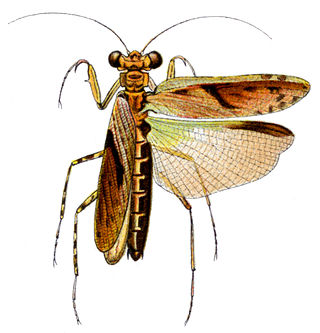
Amorphoscelidae is a family of mantises in the order Mantodea.
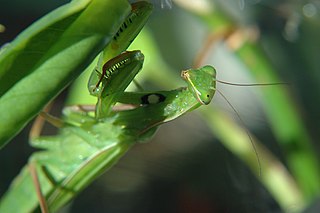
The genus Mantis is in the family Mantidae, of the mantis order Mantodea.

Zoolea is a South American genus of praying mantises.

Rhombodera is a genus of praying mantises native to Asia and possessing common names such as shield mantis, hood mantis, and leaf mantis because of their extended, leaf-like thoraxes.

Acanthops is a genus of mantises in the family Acanthopidae, containing 20 species that can be found in Central and South America.
Bolivaroscelis is a genus of praying mantis in the family Amorphoscelidae.
Caudatoscelis annulipes is a species of mantis in the family Amorphoscelidae.
Caudatoscelis collarti is a species of mantis in the family Amorphoscelidae.
Caudatoscelis lagrecai is a species of mantis in the family Amorphoscelidae.
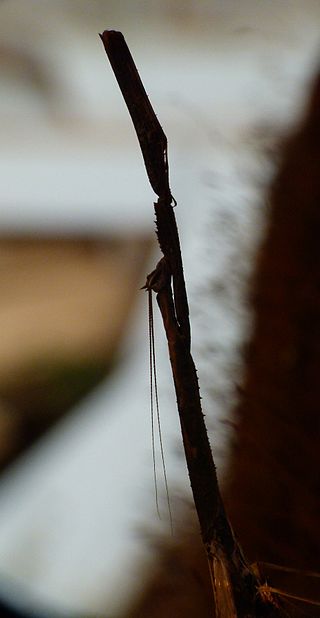
Toxoderidae is a family of praying mantises.

Acanthopidae is a family of mantises consisting of 16 genera in the order Mantodea. The group was first formally split off as a separate family by the German entomologist Reinhard Ehrmann in 2002. In 2016, five genera were moved from Acanthopidae to the newly created family Acontistidae, but this has not been accepted in most recent classifications.

Sibylla is a genus of mantises in the family Hymenopodidae and characteristic of the subfamily Sibyllinae.
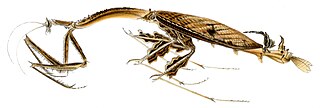
Toxodera is the type genus of mantises in the family Toxoderidae, known for their stick mimicry. There are four confirmed species in Borneo restricted to old-growth forests, and are considered to be rare. Species of the South-East Asian Toxoderini inhabit beneath the forest canopy. Not much is known regarding their ecology. Males however, are often attracted to lights. One species, Toxodera maxima, can reach 18 cm in total length.
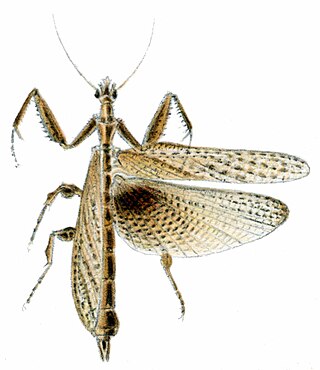
Stenophylla is a genus of praying mantis in the subfamily Stenophyllinae, which is now placed in the family Acanthopidae. It the sole genus of the tribe Stenophyllini.
Vespamantoida is a genus of praying mantises in the family Mantoididae. The genus was erected in 2019 and the name was derived from the Latin word vespa which means wasp and Mantoida referring to the mantis. These mantis resemble and mimic the behavior of a wasp.
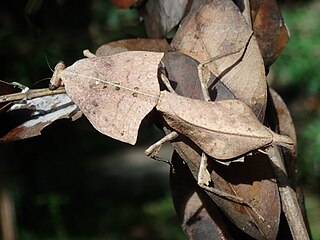
The Deroplatyidae are a new (2019) family of praying mantises, based on the type genus Deroplatys. As part of a major revision of mantis taxonomy, the subfamily Deroplatyinae has been moved here from the previously-structured family Mantidae.
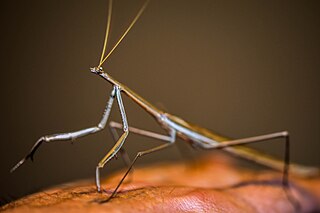
Hoplocoryphidae is a newly erected (2019) family of praying mantids, based on the type genus Hoplocorypha. As part of a major revision of mantid taxonomy, genera have been moved here from the subfamily Hoplocoryphinae of the previously polyphyletic family Thespidae. The family Hoplocoryphidae is the only member of superfamily Hoplocoryphoidea. Species in this family have been recorded from tropical Africa.
Dactylopterygidae is a family of praying mantises, based on the type genus Dactylopteryx. The first use of "Dactylopterygidae" was by Giglio-Tos and it has recently (2019) been revived as part of a major revision of mantis taxonomy; three genera have been separated from others in the subfamily Liturgusinae and moved here from the family Liturgusidae.












